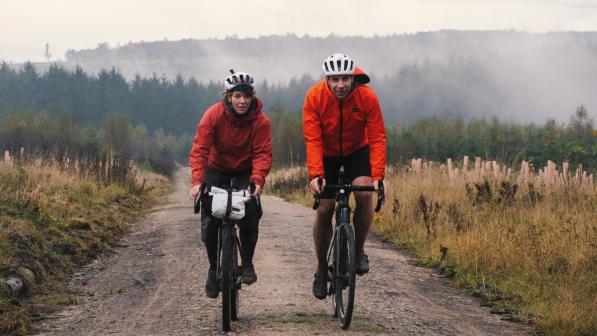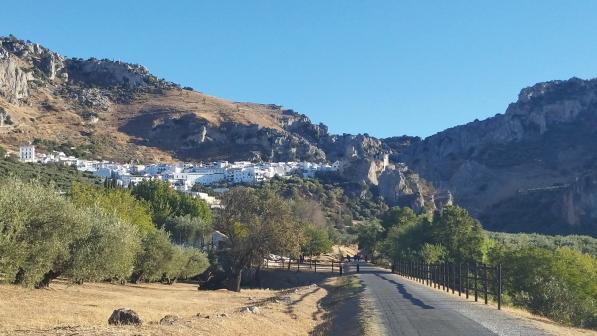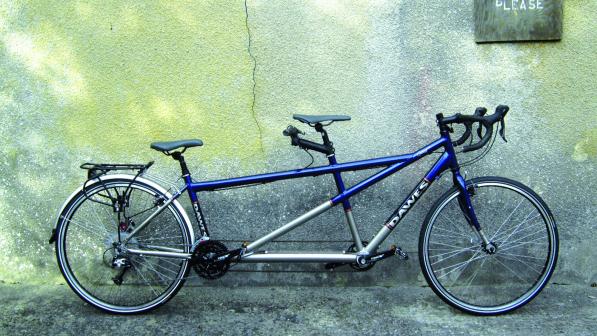Great rides: A long ride home

“How about riding the Pino down next time?” Paul asked, as the long hours passed on a drive back up to Santander. It was March and the high plateau seemed devoid of life, thick with apparently dead vines, interesting geological features and snow on the higher mountains.
My love of cycle touring had recently been reawakened. Major surgery in 2015 had left me weakened but not beaten, and the motor on the Hase Pino tandem helps both of us enjoy riding a tandem again. But could we really cover such a large distance on it?
We’d made the journey to Dénia so many times in winter (at one time leading CTC tours there) that we’d ended up buying a small home there. But it seemed a long way to ride.
We did some planning, splitting up the route into bite-sized pieces. Some months later, with one pannier each and a spare battery in our rack-top bag, we set off.
Plymouth to Santander
Our strange-looking tandem attracts incredulity wherever we go. With the pilot sitting at the back and the stoker in a recumbent position at the front, conversation between us is easy. But for me as the stoker, going downhill is sometimes just a little too exciting!
We spent four-and-a-half days riding through England, through the Forest of Dean, the Somerset Levels and the savagely hilly but beautiful Devon countryside. We met up with friends along the way, and we also had an opportunity to put our waterproofs to the test.

Our overnight ferry crossing was sandwiched between easy days, so our first day’s riding in Spain was along a flat via verde (disused railway line) with a velvety smooth tarmac surface.
We rode among mountains cloaked in the deep greens of broadleaf woodland, with cows and sheep grazing beside our route. When we reached our hotel, we found that we would be sleeping beneath lace-edged sheets, apparently a Cantabrian custom.
Away from the coast the Spanish landmass rises to an average of around 1,000m above sea level, forming an undulating high plateau known locally as La Mesita (the little table).
On our second day in Spain we climbed onto it – a steep and challenging climb. We watched the geological and agricultural landscape change as we rode over the watershed of the northward-flowing rivers towards the mighty River Ebro, which flows towards the Mediterranean Sea.
The scent of wildflowers accompanied us as we descended into low woodland and to our boutique hotel in a dry, dusty village, where the charming owner cooked especially for us.
Across the high plateau
We stayed with the River Ebro the next day, as it ran through a deep gorge with spectacular rock formations. There was more climbing, and a headwind made our going hard.
All around were fields of yellow-leaved, dying sunflower plants, ready to give seed, and in the distance their colour was everywhere. In this big landscape the agriculture was of a type and on a scale I had never seen before.

We spent a night in the beautiful cathedral city of Burgos, riding out of it on another via verde, this time with a less forgiving surface. We opted to switch to a main road but had it almost to ourselves – the very few vehicles that there were gave us a good margin of safety as they overtook us.
Even the tarmac was beautiful, with its honey-coloured aggregate. All around the big landscape was painted in ochres and greens. There was colour wherever we looked.
Gradually we approached a huge escarpment. At its highest point, around two dozen vultures were circling on air currents. We kept stopping just to admire it all. But rain caught us. It fell heavily for what were, fortunately, two of our shorter days.
With the wet weather behind us, the sunflowers were now joined by purple heather and low, pale trees, which together with the red earth created a heady cocktail of colour. We began to see vines laden with grapes, looking nothing like the twisted black dead versions we see during our winter visits.
But we picked up the unmistakable smell of pigs, too. They were hidden from the sun in long, ventilated barns. There were so many of them that now I could see why the Spanish seem to eat so much pork.
Mediterranean warmth
When we rolled into Teruel, a place we know well and which we have often used as an overnight stop when driving down in winter, it was a pleasure to see it busy with people on a warm, sunny day. We chatted to a Spanish cyclist there, the only other cycle tourist we saw throughout the whole trip.
We were coming to the end of our tour, but our penultimate day was remarkable in many ways. The temperature climbed from around 9ºC to 30ºC as we descended more than 1,000m down a series of steep hairpins between the bases of an extensive wind farm, the power of which we could almost feel.

We stopped in Valencia for lunch, and found it at a locals’ café serving the Spanish customary ‘menu del dia’, an €11 bargain (three courses, wine and coffee) that we seek out whenever we can. Then we carried on down the coast.
With full stomachs and a following wind to add to our downhill advantage, we covered more than 100 miles without flattening even one battery.
On our last day we cycled on roads we knew, picking our way along flat, coastal lanes to a triumphant finish on the shady main street at Dénia. The ride had been a joy from start to finish. I hadn’t wanted it to end.
Six days later we flew back to the UK, leaving our tandem in Spain, ready for our next winter visit. Now I can’t help looking forward to our next tour. Maybe we’ll ride the route in reverse!
Cycle magazine
Every two months Cycling UK members receive Cycle magazine, filled with interesting and informative articles, news and reviews for all cyclists.
Members can read the magazine in full online; non-members can read selected highlights.



